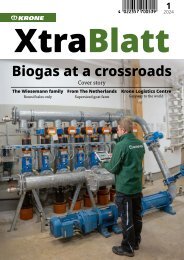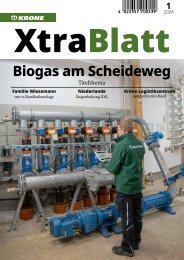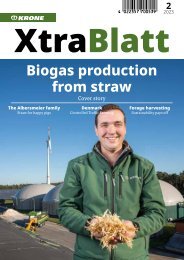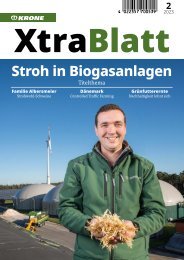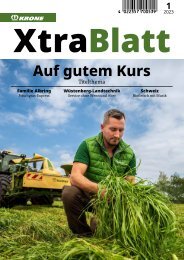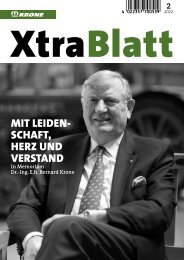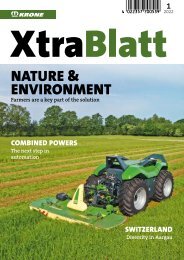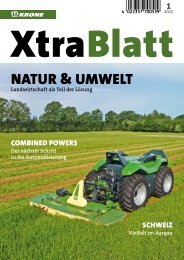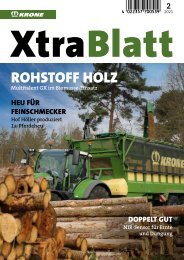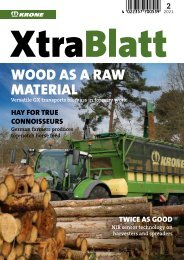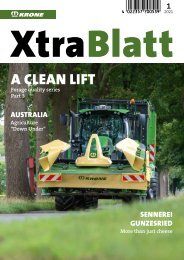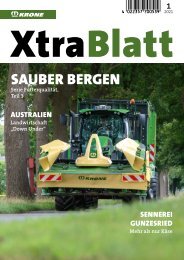XtraBlatt Issue 01-2023
You also want an ePaper? Increase the reach of your titles
YUMPU automatically turns print PDFs into web optimized ePapers that Google loves.
The Albring Farm<br />
has grown in several<br />
stages during the last<br />
20 years. Some of<br />
the young stock and<br />
heifers are now kept<br />
on a second farm.<br />
a different story: 3.7% protein and 4.3% fat speak<br />
for themselves. Even more important in terms of<br />
profitability are the low veterinary costs as a result<br />
of good welfare conditions, a good diet and an<br />
average of four lactations per cow. “The majority of<br />
our cows produce even more milk; yet in 2<strong>01</strong>0 we<br />
started replacing Holstein Frisians by Simmentals.<br />
With this breed some cows are stuck at 20kg per<br />
day, so we sell them more quickly, which reduces<br />
the average herd productivity slightly. The main<br />
advantage of Simmentals, however, is their beef<br />
performance. Also, Simmental bull calves achieve<br />
significantly higher prices than Holsteins. All in<br />
all, the numbers add up very well for us,” Monique<br />
Albring explains.<br />
A compact combination<br />
for safe travel on<br />
the narrow country<br />
roads.<br />
André calculates an average of 40kg TMR per cow<br />
per day in summer, the ration consisting of 24kg<br />
of silage maize, 8kg of grass silage, 1kg of soya, 2kg<br />
of rapeseed meal and 5l of water. In addition, he<br />
feeds each cow up to 40kg of fresh grass each day,<br />
although this is not mixed in with the TMR, but<br />
laid on top of it. During the winter, when no fresh<br />
grass is available, he increases the TMR to around<br />
50kg per cow per day and adds soya meal to the<br />
mix. The ration is fed out every morning and then<br />
banked back up several times a day with the wheel<br />
loader. As mentioned, the fresh grass is fed during<br />
the morning although the ideal time would be in<br />
the afternoon. “But then no cow would come to<br />
the milking parlour before the last blade of grass<br />
had been eaten – and that would interfere with our<br />
workflow,” he grins.<br />
Strict cost accounting<br />
The third plus point of feeding fresh grass is<br />
cost effectiveness. On the cost side, there is of<br />
course the machinery to factor in – front mower<br />
and forage wagon – plus labour and fuel costs for<br />
cutting and bringing in the grass, which takes<br />
around 1 h/day. But on the credit side, there are<br />
savings especially on soya meal. “When soya prices<br />
skyrocketed nearly 100% in 2022, this was the<br />
main factor behind our decision to consider fresh<br />
grass as an alternative. Today we replace around<br />
600kg of soya with fresh grass every day.” Over<br />
the course of 180 days, that’s an annual saving of<br />
around 108t or, based on the current price for non-<br />
GMO-soya of around 540€/t (as of May <strong>2023</strong>), more<br />
than €58,000. In 2022 it was almost €65,000. “For<br />
this reason alone, fresh grass is an entirely logical<br />
decision for us. On top of that, there are many other<br />
aspects such as animal health and palatability of<br />
the feed and the associated higher uptake, which<br />
has ultimately increased milk yields per animal<br />
and lactation period by up to 150l, according to our<br />
calculations,” explains André. Also, sustainability<br />
increases as we replace at least some of the soya.<br />
This is another important aspect – especially from<br />
the consumer’s point of view – which must not be<br />
underestimated.<br />
On top of looking after family – four children, six<br />
farm staff including one apprentice – and helping<br />
out on the farm, she is in charge of the office work.<br />
As a qualified bank clerk, profitability is something<br />
she clearly understands. “Profitability has been<br />
hugely important for us right from the start, because<br />
when we took over in 2000 we had very little<br />
equity. We had 10ha of owned land, 30ha of leased<br />
land and 40 cows. Then we have gradually grown<br />
to our current size – without skating on too thin<br />
ice in financial terms. That wouldn’t have worked,<br />
if viability hadn’t been our absolute premise,” she<br />
adds. «<br />
Albring Farm in brief<br />
230ha of land, 180ha of which is grassland<br />
480 dairy cows plus offspring<br />
Average milk production: 8,000l/animal/year<br />
with 3.7% protein and 4.3% fat<br />
Feeding fresh grass in summer reduces soya<br />
consumption by around 108t/year<br />
Digital through and<br />
through: electronic<br />
control systems and<br />
camera in the tractor<br />
cab.<br />
The TMR consists of<br />
silage maize, grass<br />
silage, soya, oilseed<br />
rape and water.<br />
The average milk yields of the Albring herd currently<br />
stand at 8,000 litres per cow – so it’s not<br />
exceptionally high. But the “inside milk values” tell<br />
50 1|<strong>2023</strong> <strong>XtraBlatt</strong><br />
<strong>XtraBlatt</strong> 1|<strong>2023</strong><br />
51



